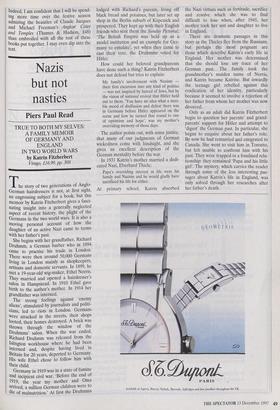Christmas art books
David Ekserdjian
The great event of the artistic year is the opening of the new J. Paul Getty Museum, and it is being celebrated by seven handy guidebooks devoted to the various curatorial departments (Thames & Hudson, £12.95). Of these, Illuminated Manuscripts and Decorative Arts, with its exceptionally fine French furniture, are particularly eloquent demonstrations of the fact that it is almost never too late to make illustrious collections.
Having said that, the Getty will never rival the best of Europe. Treasures from the Italian Libraries, edited by Lorenzo Crinelli (Thames & Hudson, L40), makes that abundantly clear by parading masterpiece after masterpiece before us. A visit to the V & A or the National Gallery would have the same effect. The former is moving away from the worst excesses of 'Ace Caff'-itis, and producing its own anthologies of its collections. Marian Campbell's Decorative Ironwork and Mark Haworth-Booth's Photography: an Independent Art (V & A Publications, £25 and £35) are by no means uniform, however. The former is rightly conscious of the need to place its superficially rather rarefied subject in a wider context, and points out that ironwork is truly all around us. The latter, in contrast, traces the history of the V & A's photographic collection alongside the history of photography, and includes the fascinating information that the Museum beat Eugene Atget down from 1 franc 50 centimes per photograph to 1 franc 25 centimes just after the turn of the century.
As for the National Gallery, they have launched a series of thematic pocket guides which could be almost infinitely prolonged. The first four (NG Publications/Yale £6.50) are Frames by Nicholas Penny, Conserva- tion of Paintings by David Bomford, and Landscapes and Allegory, both by Erika Langmuir. They are compact and concise, but it would be a big mistake to suppose that they are simply bland repetitions of old truths.
Exhibitions and restorations spawn more than their fair share of art books, and the former are almost invariably designed with eternity as opposed to visiting in mind. Rudolf II and Prague: The Court and the City (Thames and Hudson/Skira, £48) at 792 _pages, is a particularly extreme example, but does contain a miraculous anthology of all the visual arts and much else besides from that most magical of cities at the acme of its achievement. The essays that precede the catalogue are seri- ous and learned, but they are also peppered with a generous array of colour plates.
Monographic exhibitions remain more common than thematic ones, and I have chosen two from a larger crop. Lorenzo Lotto (National Gallery of Art, Washing- ton/Yale, £40) is subtitled 'Rediscovered Master of the Renaissance', which seems odd in view of the fact that Berenson devoted a monograph to him over a century ago. His inner torments and uncertainties seem to be writ large in his art, but that allusiveness and eccentricity were not punished in his own day, either. This show will travel on to Bergamo and Paris, and looks hard to resist. Polenta- lovers will know where to try to see it. Hilary Pyle's Yeats: Portrait of an Artistic Family (Merrell Holberton, £35) is a cata- logue designed for a permanent display within the National Gallery of Ireland in Dublin. It is a timely reminder of how unlucky his father, John Butler, and his brother, Jack, were to be overshadowed by William.
Restorations these days always seem to be controversial — and they certainly need watching — but Michelangelo: The Last Judgement (Abrams, £45) has escaped most of the vitriol unjustly poured on the Sistine ceiling. In some ways, the transformation effected here is even more dramatic: the lightness of the palette is now thrillingly opposed to the gravity of the subject. Only the 'breeches' added by Daniela da Volter- ra, with Michelangelo's approval, to cover some of the nudity have been retained.
Amazing to relate, some art books come into being beyond the confines of the museum and the show. Clifford M. Brown and Guy Delmarcel's Tapesteries for the Courts of Federico II, Ercole and Ferrante Gonzaga 1522-63 (Merrell Holberton, £30) is a case in point, and represents a sober but absorbing excavation of a neglected art form whose status could hardly have been higher in the Renaissance. Andrew Butter- field's The Sculptures of Andrea del Verroc- chio (Yale, £45) covers more familiar ground, but the creator of such public tours de force as the Colleoni monument has never been approached with such under- standing. Indeed, the easy authority of the scholarship runs the risk of leading the reader to overlook the fact that there are startling revelations and surprises on almost every page.
The idea behind Dora Thornton's The Scholar in His Study (Yale, £35) is, like the best inspirations, so obvious in retrospect that it seems astonishing nobody thought of it before. This really is history as well as art, but the splendidly chosen illustrations ensure that it is not only the former.
If the distinction between `semasiograph- ic' and `glottographic' writing is not old hat to you, then you may find parts of Michael D. Coe and Justin Kerr's The Art of the Maya Scribe (Thames & Hudson, £45) heavy going, although it has a lot of the excitement of a good whodunnit. At worst, one can always look at the pictures.
Not all so-called 'primitive' art is ultra- sophisticated, but both the Mayas and the Khmers are more than able to hold their own with anything Europe has to offer. Indeed, I am confident that I will be spend- ing more time over the festive season admiring the beauties of Claude Jacques and Michael Freeman's Angkor: Cities and Temples (Thames & Hudson, £48) than embroiled with all the rest of these books put together. I may even dip into the text.



















































































 Previous page
Previous page